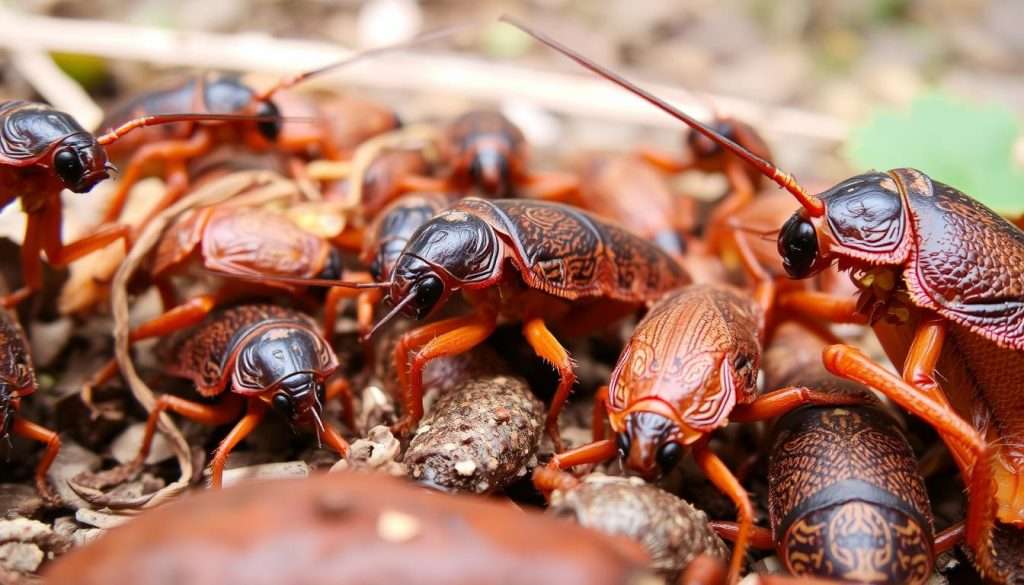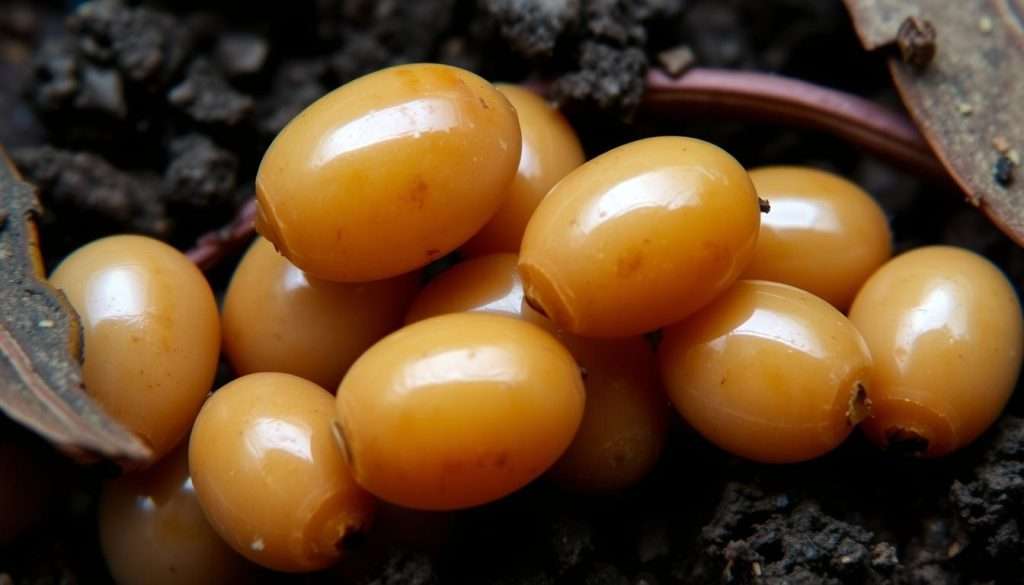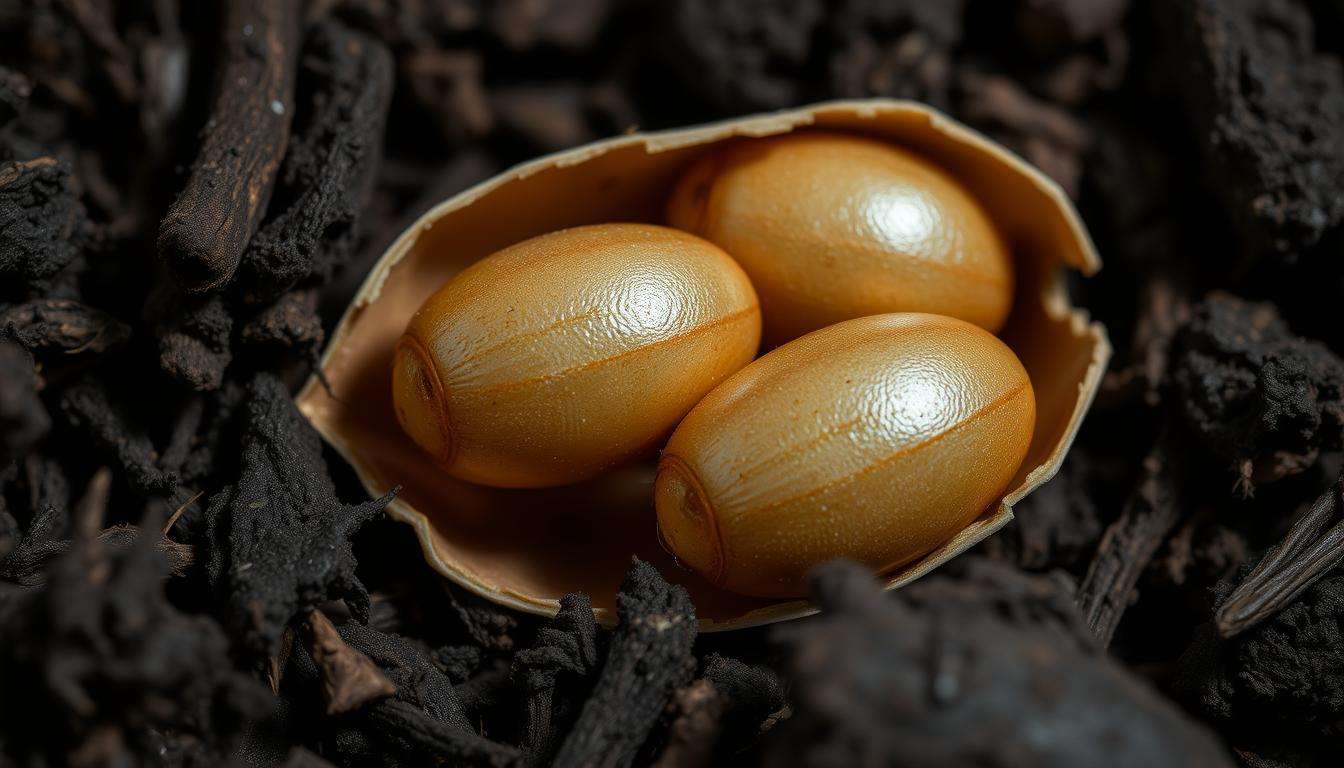Cockroach eggs are often the first sign of an infestation in your home. If you’re a homeowner or a DIY enthusiast, knowing what cockroach eggs look like is key. These eggs are in cases called oothecae. They protect many eggs until they hatch.
These eggs are small and oval-shaped, about 1/4 inch long. Knowing this helps you act fast against these pests. This way, you can keep your home safe for you and your family.
Key Takeaways
- Cockroach eggs are encapsulated in protective cases called oothecae.
- Understanding cockroach egg appearance is vital for pest control.
- Most oothecae vary in size but are generally smaller than 1 cm.
- Health risks of cockroach eggs emphasize the importance of early identification.
- Each species exhibits unique characteristics of their eggs.
Understanding Cockroach Eggs
Cockroach eggs are in protective casings called oothecae. These casings keep the eggs safe from predators and harsh conditions. Each ootheca can hold 16 to 50 eggs. The female cockroach carries her oothecae until the eggs are almost ready to hatch.
This protects the young until they’re ready to emerge. Understanding cockroach reproduction is key to controlling pests. For example, German cockroaches can lay up to 300 eggs, leading to 300,000 offspring a year.
Seeing cockroach eggs means you have a big problem. These eggs are not sticky and hide in warm, dark, and moist spots. Knowing this helps you fight pests before they spread.
What Do Cockroach Eggs Look Like
Knowing what cockroach eggs look like is key to spotting pests. These eggs vary in size and look based on the type of cockroach. Spotting these differences can tell you if you have a pest problem.
Cockroach Egg Appearance
Cockroach eggs are usually oval and have a special texture. The way they look can tell you which type of cockroach you have. For example, German cockroach eggs are small and smooth. American cockroach eggs are bigger and have ridges.
- German Cockroach: 1/4 inch in length
- American Cockroach: 3/8 inch in length
- Brown Banded Cockroach: less than 1/4 inch
- Oriental Cockroach: 3/8 inch in length
Cockroach Egg Color
The cockroach egg color can be light or dark. New eggs are often white but get darker as they grow. Here’s a quick guide to different types:
| Species | Egg Color | Egg Size |
|---|---|---|
| German Cockroach | Light brown | 1/4 inch |
| American Cockroach | Dark brown | 3/8 inch |
| Brown Banded Cockroach | Light brown | Less than 1/4 inch |
| Oriental Cockroach | Dark brown | 3/8 inch |
Each egg sac can hold a different number of eggs. This affects how fast a cockroach population can grow. For example, German cockroaches can lay 20 to 40 eggs at a time. Knowing cockroach egg size and color helps keep pests away.
Types of Cockroach Oothecae
Cockroach eggs, or oothecae, are key to their life cycle. Each species has its own egg case design. These designs help identify the species and spot infestations.
Cockroach Egg Description by Species
Looking at different cockroach eggs shows unique features. Here’s a quick look at the most common types:
German Cockroach Eggs
German cockroach eggs are carried by the female until they hatch. Each egg case holds up to 50 eggs and is about 6-9 mm long. A female lays one ootheca every three to four weeks.
Nymphs take about 36 days to grow up. This fast breeding helps German cockroaches spread quickly in homes.
American Cockroach Eggs
American cockroach eggs have more eggs, with 15 to 90 in each ootheca. Each egg case is about 8 mm long and is often hidden. A female can lay 6 to 15 oothecae in her life.
This leads to a big increase in their numbers. They hatch in 24 to 38 days, depending on the environment.
Oriental Cockroach Eggs
Oriental cockroach eggs are in darker, inflated oothecae with about 17 eggs. Nymphs hatch in about 42 days at 29.5 °C. A female can lay up to 8 oothecae in her life.
Knowing how to spot Oriental cockroach eggs helps in controlling them.

| Species | Egg Count per Ootheca | Size of Ootheca (mm) | Incubation Period (Days) | Ootheca Production Cycle |
|---|---|---|---|---|
| German Cockroach | 30-50 | 6-9 | 28 | Every 3-4 weeks |
| American Cockroach | 15-90 | 8 | 24-38 | Multiple oothecae during life |
| Oriental Cockroach | 17 | Darker, inflated | 42 | 8 oothecae |
Identifying Cockroach Eggs
It’s important to know how to spot cockroach eggs to manage pests well. Knowing the difference between eggs and frass helps stop small issues from getting big. We focus on finding unique signs that eggs have.
Cockroach Egg Identification Tips
Cockroach eggs are usually tan, brown, or black and are 0.25 to 0.50 inches long. They are oval and often found in hidden spots near food or moisture. Here are some tips to spot cockroach eggs:
- Look for small, pill-shaped capsules in dark, secluded spots like behind refrigerators or under sinks.
- Check for the distinctive ridge along the egg case, which helps break the ootheca.
- Notice the color, as fresh eggs are light brown but darken and harden over time.
- Watch for groups of eggs, as females can drop one ootheca every 10 days, and each may contain up to 50 eggs.
Seeing cockroach eggs means it’s time to call professional pest control services. Early action stops damage and keeps your home clean.
Differences Between Eggs and Frass
Knowing the difference between eggs and frass is key for cockroach egg identification. Eggs are small and oval, while frass looks like ground pepper or coffee grounds. It’s often found where cockroaches live.
| Feature | Cockroach Eggs | Frass |
|---|---|---|
| Appearance | Pill-shaped capsules | Ground pepper or coffee grounds |
| Color | Tan, brown, or black | Dark brown to black |
| Location | Hidden areas near food | Along pathways or resting spots |
By focusing on these differences, you can stop cockroach infestations. Keep your home clean and food stored properly to avoid these pests.
Common Locations for Cockroach Eggs
Cockroaches are known for hiding when they lay eggs. Knowing where they lay eggs helps prevent infestations. They like dark, hidden spots near food and water. So, it’s important to check these areas well.
Areas to Find Cockroach Eggs
Look for cockroach eggs in these places:
- Under sinks and behind appliances
- Inside cupboards and pantries
- Behind baseboards and in corners
- Near drains and trash cans
- Inside furniture or stored items
Concealed Spaces where Eggs are Laid
Cockroach eggs are often found in unexpected places. Look in:
- Damp areas like basements and bathrooms
- Crawl spaces and attics
- Cardboard boxes and storage containers
- Behind or underneath large appliances
- Inside walls or attics, where they can remain undisturbed
Cockroach Egg Size and Shape
Knowing about cockroach egg size and shape is key to spotting pests. It helps in controlling infestations well. The size and shape of oothecae, or egg cases, differ by species but are mostly similar.
Cockroach Egg Size Measurements
Cockroach eggs are usually 0.06 to 0.18 inches long. Here’s a quick look at egg sizes for different cockroach types:
| Species | Average Egg Size | Ootheca Size | Average Number of Eggs per Ootheca |
|---|---|---|---|
| German Cockroach | 1/4 inch | 0.25 – 0.5 inch | 40 – 50 |
| American Cockroach | 1/4 inch | 0.25 – 0.5 inch | 16 – 50 |
| Oriental Cockroach | 1/4 inch | 0.25 – 0.5 inch | 10 – 20 |
| Brown-Banded Cockroach | 1/4 inch | 0.25 – 0.5 inch | 10 – 18 |
Cockroach Egg Shape Characteristics
The usual shape of cockroach eggs is oval. The egg casings can have different textures based on the species. For example, German and brown-banded cockroaches have ridged egg casings. Others, like the American cockroach, have smoother ones. These details are important for identifying pests.

Cockroach Egg Development and Life Cycle
Cockroach egg development is fascinating. It shows the stages of life these insects go through. Knowing this helps us manage and prevent infestations better.
From Egg to Nymph
A mother cockroach can carry 6 to 40 eggs in an ootheca. She attaches it to her abdomen. These eggs take one to two months to hatch.
When they hatch, young cockroaches, called nymphs, come out. This stage lasts several months to nearly a year. Nymphs molt several times before becoming adults.
Life Cycle Duration According to Species
The life cycle of cockroaches varies by species. For example, German cockroaches’ eggs hatch in 18 days. American cockroaches take 24 to 60 days.
The table below shows key life cycle details for several species:
| Species | Eggs per Ootheca | Time to Hatch (Days) | Nymph Stage Duration (Months) | Adult Lifespan (Years) |
|---|---|---|---|---|
| German Cockroach | 30-48 | 18 | 2-3 | 1-2 |
| American Cockroach | 10-30 | 24-60 | 6-12 | 1-2 |
| Oriental Cockroach | 16-32 | 30-50 | 3-6 | 1-2 |
By knowing these life cycles, we can control cockroach populations better. Quick action is key, especially since one female German cockroach can have nearly 300,000 offspring in a year.
Health Risks Associated with Cockroach Eggs
Cockroach infestations can harm you and your family’s health. These pests spread diseases and cause allergic reactions. It’s important to know the dangers of infestations to keep your home healthy.
Dangers of Cockroach Infestations
Cockroaches carry harmful bacteria. They spread over 33 types of bacteria, six parasitic worms, and seven pathogens. This can make surfaces and food dirty, causing stomach problems.
In places like Dallas, where asthma is common, cockroach eggs are a big risk. Their allergens can make breathing hard, leading to coughing, wheezing, and shortness of breath.
Health Hazards from Cockroach Eggs
Health problems from cockroach eggs go beyond bacteria. Their feces, saliva, and body parts are allergens that cause long-term symptoms. Unlike seasonal allergies, these can be serious and last a long time.
They can cause skin rashes, nasal congestion, ear infections, and sinus infections. Touching cockroach eggs can irritate your skin and trigger allergies. It’s key to spot infestations early to avoid health risks.
Conclusion
Knowing about cockroach eggs is key to keeping your home pest-free. Spotting these eggs and understanding their growth stages helps you act fast. Eggs in oothecas can hatch quickly, leading to fast infestations if not caught early.
Regular checks are crucial to keep your home pest-free. Look for signs like shed skins, droppings, and live roaches, especially in damp places like kitchens and bathrooms. Clean up food and seal entry points to prevent pests. The sooner you tackle a cockroach problem, the better.
While DIY efforts can help, sometimes you need professional pest control for big infestations. Experts do thorough checks and use targeted treatments to get rid of eggs and adults. Being informed and watchful helps us keep our homes safe and healthy for everyone.
